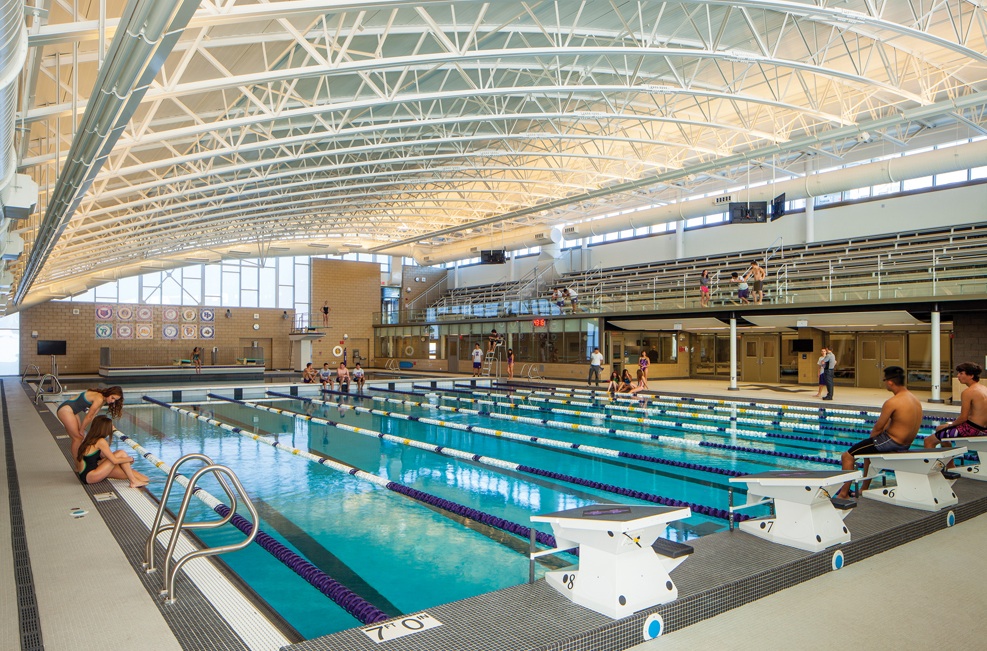The Building Team for the new Aquatics Center at Niles North High School in Skokie, Ill., included Chicago-area firms Legat Architects and IHC Construction—but a case could be made for listing a much larger group of official participants. The AEC firms made a concerted effort to involve not only district officials but also the user community. As a result, the project became a unique learning experience for students, staff, and neighbors.
The Niles North Aquatics Center serves 2,200 students—all of whom must take swimming—as well as 275 competitive student athletes in swimming, diving, and water polo. Feeder programs from park districts and local partners are also housed there. By 2012, the pool in the 48-year-old building was considered too small and shallow to meet current requirements.
Stakeholders asked for a new competition “cold pool,” a renovated community-accessible “warm pool,” a new public connecting corridor, locker room renovations, coaches’ offices, and meeting and storage space. Lighting and mechanical systems also needed an energy upgrade.
SILVER AWARD
Project summaryNiles North High School Aquatics Center
Skokie, Ill.BUILDING TEAM
Submitting firm: Legat Architects (architect)
Owner/developer: Niles Township High School District 219
Structural: KJWW Engineering Consultants
Mechanical/plumbing: AMSCO Engineering
Electrical: Hansen Palmer Associates
Civil: Gewalt Hamilton
CM: IHC Construction CompaniesGENERAL INFORMATION
Project size: 39,200 sf (24,600 sf new + 14,600 sf renovated)
Construction cost: $15 million
Construction period: April 2012 to August 2013
Delivery method: Design-bid-build
District 219 teamed with Legat Architects to plan the revitalization. Students and community members were surveyed regarding their priorities, and the Building Team held design workshops that elicited feedback for the floor plan. Daylighting is an important aspect of the final design, including a mix of clerestories, clear windows, translucent windows, and internal glazing to offer glare-free illumination and visual connections.
Eventually, the project was incorporated into the district’s architecture and engineering class curriculum. Biweekly tours were coordinated with faculty to focus on current classroom topics, and students were able to receive insights on various career paths.
“It became quite the living classroom,” says Building Team Awards judge Nathan Snydacker, PE, LEED AP, Vice President at Environmental Systems Design.
“It’s a lot of involvement you’d want in a school project of this type,” adds BTA judge Terry Fielden, LEED AP BD+C, Director of K-12 Education for International Contractors.
The Building Team phased construction over two summers to minimize disruption, keeping the community involved with a blog, video tours, signage with QR codes, and outreach to local news outlets.
In spring 2013, a severe flood created leaks in the lower-level filtration room. The damage stalled excavation and construction of the pool slab and walls, but IHC Construction, Legat, D219 staff, and other contractors managed to keep the job on schedule and within budget.
The result is a more functional, accessible, energy-efficient facility, designed to use 42% less water and 44% less energy than typical natatoriums. The project, whose heat-recovery dehumidification units should also sharply reduce CO2 emissions, is expected to become the first aquatic center in Illinois to achieve LEED for Schools Gold certification.
Related Stories
| Jun 10, 2014
New York's first-ever public housing for visually-impaired begins upgrade
Selis Manor is the first government-funded residence for the vision-impaired and disabled in New York City. MAP’s design eases crowding, increases security, and separates residents and visitors.
| Jun 9, 2014
6 design strategies for integrating living and learning on campus
Higher education is rapidly evolving. As we use planning and design to help our clients navigate major shifts in culture, technology, and funding, it is essential to focus on strategies that help foster an education that is relevant after graduation. One way to promote relevance is to strengthen the bond between academic disciplines and the campus residential life experience.
| Jun 9, 2014
Green Building Initiative launches Green Globes for Sustainable Interiors program
The new program focuses exclusively on the sustainable design and construction of interior spaces in nonresidential buildings and can be pursued by both building owners and individual lessees of commercial spaces.
| Jun 9, 2014
10 projects named 2014 AIA Small Project Award winners
Yale's funky new Ground café and a pavilion made from 53,780 recycled plastic bottles are among the nation's best new small projects.
| Jun 9, 2014
Eli Broad museum files $19.8 million lawsuit over delays
The museum, meant to hold Eli and Edythe Borad's collection of contemporary art, is suing the German company Seele for what the museum describes as delays in the creation of building blocks for its façade.
| Jun 8, 2014
What’s the word of the day? It’s all about ‘resiliency’
Just for the sake of argument, let’s put aside the rhetoric about climate change—whether it’s actually happening, whether it’s a result of manmade activity—and agree that we are experiencing some pretty dramatic weather events that are having huge impacts on populations here in the U.S. and worldwide.
Smart Buildings | Jun 8, 2014
Big Data: How one city took control of its facility assets with data
Over the past few years, Buffalo has developed a cutting-edge facility management program to ensure it's utilizing its facilities and operations as efficiently, effectively, and sustainably as possible.
| Jun 6, 2014
Must see: Can a floating city offset urban population growth in China?
AT Design Office has proposed a design for a floating city to offset increasing urban populations in China. To create the new city, a 10-square kilometer island would be made out of prefab blocks.
| Jun 6, 2014
KPF, Kevin Roche unveil design for 51-story Hudson Yards tower in NYC [slideshow]
Related Companies and Oxford Properties Group are teaming to develop Fifty Five Hudson Yards, the latest addition to the commercial office tower collection in the 28-acre Hudson Yards development—the largest private real estate development in the history of the U.S.
| Jun 6, 2014
Shipping container ship terminal completed in Spain
In Seville, Spain, architectural firms Hombre de Piedra and Buró4 have designed and completed a cruise ship terminal out of used shipping containers.
















